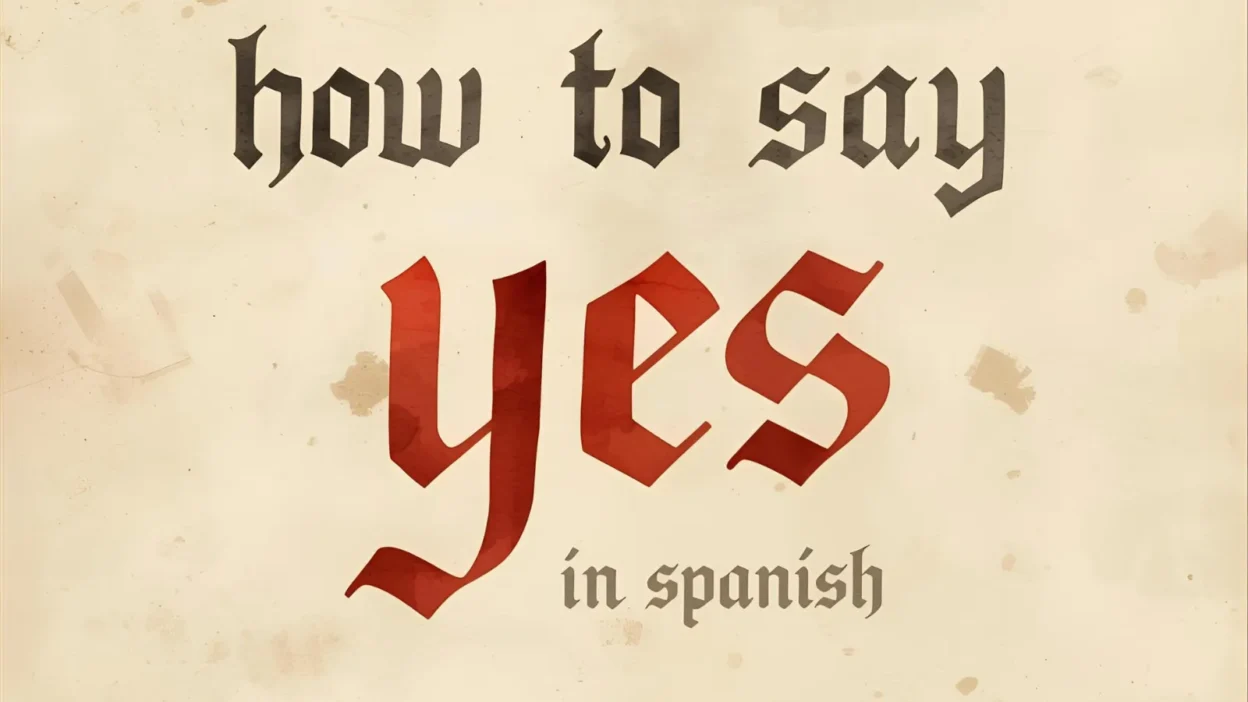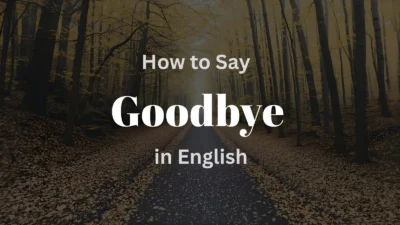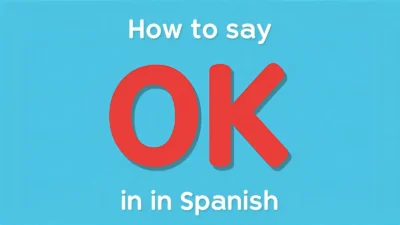Learning how to say yes in Spanish is one of the first steps to understanding everyday conversations. The most common word is “sí”, but depending on the tone and situation, there are many other ways to agree politely, casually, or enthusiastically.
Mastering these variations will help you sound more natural and confident when speaking with native Spanish speakers. By exploring these phrases, you’ll also understand the cultural nuances of agreement in Spanish-speaking countries.
Whether in daily chats, travel, or work, knowing how to say yes makes communication smoother and friendlier.
Yes in Spanish With Examples
15 Phrases Table
| No. | Spanish Phrase | English Meaning | Use / Tone |
|---|---|---|---|
| 1 | Sí | Yes | Standard, most common |
| 2 | Claro | Of course | Friendly, casual |
| 3 | Claro que sí | Of course, yes | Emphatic |
| 4 | Por supuesto | Of course | Formal, polite |
| 5 | Desde luego | Certainly | Polite, formal |
| 6 | Vale | Okay / Yes | Common in Spain |
| 7 | Bueno | Okay, fine | Casual agreement |
| 8 | De acuerdo | Agreed / Okay | Neutral, polite |
| 9 | Correcto | Correct | Formal |
| 10 | Exacto | Exactly | Confirming agreement |
| 11 | Sí, cómo no | Yes, why not | Polite/agreeable |
| 12 | ¡Eso es! | That’s it! | Energetic agreement |
| 13 | Afirmativo | Affirmative | Formal / technical |
| 14 | ¡Ya! | Yeah / Okay | Informal, casual |
| 15 | ¡Por qué no! | Why not! | Playful agreement |
15 unique and authentic ways to say yes in Spanish, complete with real conversation examples and the background behind each phrase.
1. Sí – The Classic “Yes”

Origin:
“Sí” is the standard word for “yes” in Spanish and comes from Latin sic, meaning “thus” or “so.”
Example:
👤 Usuario A: ¿Quieres ir al cine esta noche?
👤 Usuario B: Sí, claro. ¡Me encanta esa idea!
Use: Universal, standard “yes” in all Spanish-speaking countries.
2. Claro – Of Course
Origin:
Means “clear” in Spanish. It’s short for claro que sí (clearly, yes).
Example:
👤 Usuario A: ¿Me puedes ayudar con esto?
👤 Usuario B: Claro, no hay problema.
Use: Friendly, confident affirmation.
3. Por supuesto – Of Course / Absolutely

Origin:
Literally “by supposition,” this phrase dates back to formal Castilian Spanish.
Example:
👤 Usuario A: ¿Puedo acompañarte al evento?
👤 Usuario B: Por supuesto. ¡Será divertido!
Use: Formal or polite; strong agreement.
4. Desde luego – Certainly / Of Course
Origin:
Translates as “from then on,” evolved into a phrase meaning certainty.
Example:
👤 Usuario A: ¿Te parece bien si te llamo mañana?
👤 Usuario B: Desde luego, estaré esperando tu llamada.
Use: Formal or educated tone in Spain and Latin America.
5. Vale – Okay / Sure (Spain)
Origin:
Popular in Spain, it comes from the verb valer (to be worth, to be okay).
Example:
👤 Usuario A: ¿Quedamos a las cinco?
👤 Usuario B: Vale, nos vemos entonces.
Use: Everyday “okay” or “yes” in Spain; less common in Latin America.
6. Ajá – Uh-huh / Yep
Origin:
A phonetic agreement sound, like the English “uh-huh.”
Example:
👤 Usuario A: Entonces, ¿estás de acuerdo con el plan?
👤 Usuario B: Ajá, totalmente.
Use: Casual and informal; often used during conversations to show active listening.
7. Sí, señor / Sí, señora – Yes, sir/ma’am

Origin:
Respectful affirmations rooted in Spanish honorific traditions.
Example:
👤 Usuario A: ¿Hiciste tu tarea?
👤 Usuario B: Sí, señor. La terminé hace una hora.
Use: Polite, sometimes playful or military-style respect.
8. Cómo no – Why not / Of course
Origin:
Literally “how not?” Used across Latin America.
Example:
👤 Usuario A: ¿Te gustaría un café?
👤 Usuario B: ¡Cómo no! Gracias.
Use: Polite or friendly, commonly used in Mexico, Colombia, etc.
9. Eso es – That’s it / Exactly / Yes
Origin:
Used when agreeing strongly or confirming what was said.
Example:
👤 Usuario A: Entonces nos vemos en la plaza, ¿no?
👤 Usuario B: Eso es. A las seis.
Use: Used to confirm a correct statement, like “exactly” in English.
10. Obvio – Obviously / Duh
Origin:
Borrowed directly from the Latin word obvius. Modern slang-style affirmation.
Example:
👤 Usuario A: ¿Vas a la fiesta?
👤 Usuario B: Obvio. ¡Ni lo dudes!
Use: Youth slang; informal, a bit cheeky.
11. ¡Sí, cómo no! – Yes, of course! / Definitely!
Origin:
An emphatic form of cómo no, used for strong agreement or enthusiastic permission.
Example:
👤 Usuario A: ¿Puedo probar tu pastel?
👤 Usuario B: ¡Sí, cómo no! Está riquísimo.
Use: Warm and enthusiastic.
12. Con gusto – Gladly / With pleasure

Origin:
Means “with pleasure”; widely used in service or hospitality contexts.
Example:
👤 Usuario A: ¿Me podrías traer otra servilleta?
👤 Usuario B: Con gusto, señor.
Use: Formal, used in customer service or polite conversation.
13. ¡Hecho! – Done! / You got it!
Origin:
Literally “done,” used when agreeing to a plan or deal.
Example:
👤 Usuario A: Entonces, ¿nos vemos mañana a las 10?
👤 Usuario B: ¡Hecho!
Use: Informal and action-oriented.
14. Va – Okay / Sounds good (Mexico, Central America)
Origin:
Short for vale, used in Mexico and Central America.
Example:
👤 Usuario A: ¿Vamos al parque después?
👤 Usuario B: Va, me parece bien.
Use: Informal regional slang.
15. De acuerdo – Agreed / Alright
Origin:
Literally “in agreement,” a formal and polite affirmation.
Example:
👤 Usuario A: ¿Te parece si hablamos luego?
👤 Usuario B: De acuerdo. Estoy ocupado ahora.
Use: Neutral to formal; often used in agreements or decisions.
FAQs
1. What is the basic way to say “yes” in Spanish?
The most common and simple word is “Sí”, with an accent on the “i.”
2. How do you pronounce “Sí”?
It’s pronounced like “see.”
3. Why does “sí” have an accent mark?
The accent mark distinguishes “sí” (yes) from “si” (if) — they have different meanings.
4. Are there other ways to say “yes” in Spanish?
Yes! You can also say “Claro” (of course), “Por supuesto” (of course), or “Desde luego” (certainly).
5. How do you say “yes” politely in Spanish?
You can say “Sí, por favor” (Yes, please) or “Sí, claro” (Yes, of course).
6. How do you say “yeah” or “yep” in Spanish?
You can say “Sí,” “Ajá,” or “Bueno,” depending on the tone — these sound casual or friendly.
7. What’s a fun or enthusiastic way to say yes?
You can say “¡Sí, claro que sí!” which means “Yes, of course!” or “Absolutely!”
8. How do you say “yes” in texting or casual chat?
People often just type “Sí” or “Siiiii” (with extra “i”s) to show excitement.
9. How do you say “yes” to agree with someone?
You can say “De acuerdo” (Agreed) or “Exacto” (Exactly).
10. What’s the opposite of “Sí” in Spanish?
The opposite is “No.” So, “Sí” means yes, and “No” means no.
Conclusion:
Learning how to say yes in Spanish gives you more than just one word—it gives you the ability to agree in ways that fit casual, formal, or enthusiastic settings. From the simple “sí” to fun expressions like “¡claro que sí!”, these phrases make your Spanish sound natural and expressive.



